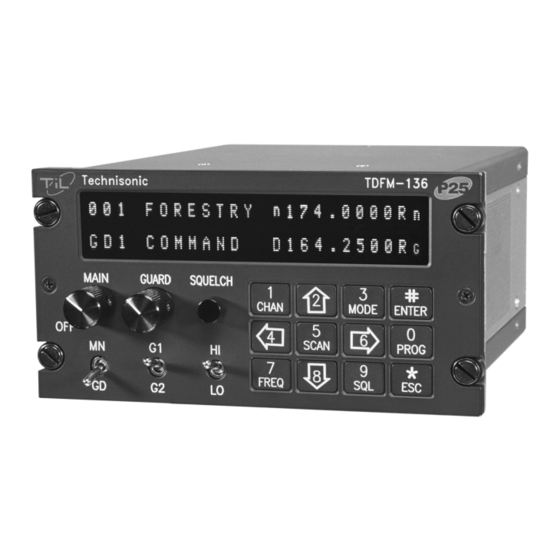
Technisonic Industries Limited TDFM-136 Manual
Hide thumbs
Also See for TDFM-136:
- Installation & operating instructions manual (45 pages) ,
- Quick reference manual (2 pages)
Advertisement
Quick Links
Advertisement

Summary of Contents for Technisonic Industries Limited TDFM-136
- Page 1 Technisonic Industries TDFM-136...
- Page 2 TDFM-136 Transceiver Operation TDFM-136 Transceiver Operation...
- Page 3 TDFM-136 Transceiver Operation TDFM-136 Transceiver Operation - Overview Radio Familiarization Front Panel Layout and Controls Basic Operation Channel and Memory Select Programming the Radio Command Architecture Operating Commands Channel Data Commands Configuration Commands ...
- Page 4 TDFM-136 Transceiver Operation Radio Familiarization - Front Panel Layout and Controls Squelch Indicators (LED) – Lights when signal is received. Channel Display (2Line x 24 character) – Shows channel parameters. MAIN (Rotary+Switch) – Power ON/OFF and Main channel volume control.
- Page 5 TDFM-136 Transceiver Operation Radio Familiarization – Channel Display Main channel information is displayed on the top row of the display. Guard channel information is displayed on the bottom row of the display. 3. The Main channel can have up to 230 memory positions (001 to 230), the current active memory number for the Main channel is shown in the first three characters of the line.
- Page 6 TDFM-136 Transceiver Operation Radio Familiarization – Channel Display The following parameters are common to both the Main and the Guard channels. 7. Up to eight characters are available for a text description of the memory. 8. One character position is used to indicate the...
- Page 7 TDFM-136 Transceiver Operation Radio Familiarization – Basic Operation The basic operation for transmit and receive is as follows: 1. The Squelch LED's are on if a valid signal has been received. 2. Upon keying the radio, the "R" character at the second from right position on the line, will change to a "T".
- Page 8 TDFM-136 Transceiver Operation Radio Familiarization – Select Channel and Memory 1. The MAIN channel data is shown on the top line of the display, MAIN supports 230 memory positions (001 to 230). MAIN is selected for edit and transmit by placing the MN/GD switch in the MN position.
-
Page 9: Command Types
TDFM-136 Transceiver Operation Programming the Radio – Command Architecture Command Types There are two types of commands: inherent and edit. Inherent commands need no further input from the user (example: display brightness commands) Edit comands need further input from the user and must end as follows:... -
Page 10: Command Description
L2-1 = command level 2, command 1 (Edit all/new channel) Command Description The commands are described in detail in both the Technisonic documents: TDFM-136 Operators Manual, (TiL document #99RE266) and the TDFM-136 Installation and Operating Instructions, (TiL document #99RE255) These documents are available on-line at www.til.ca. - Page 11 TDFM-136 Transceiver Operation Programming the Radio – Operating Commands Operating Command List The Operating Commands are distributed across Level 1, Level 2 and Level 3 as follows: Level 1 L1-1 jump to selected channel L1-2 and L1-8 change display brightness...
- Page 12 TDFM-136 Transceiver Operation Programming the Radio – Edit Commands Edit Commands - Cursor and Prompts When any Edit begins, a cursor is placed in the appropriate data field on the display, and the non-active channel becomes a prompt line. Example: for 'Edit Frequency' on the MAIN Channel, a cursor is placed at the second character in the Frequency field (1), and the Guard display row becomes a prompt line (2).
- Page 13 TDFM-136 Transceiver Operation Programming Channel Data – Edit Commands Edit Command List The Edit Commands are distributed across Level 1 and Level 2 as follows: Level 1 L1-3 Edit current Operating Mode (analog wide, analog narrow, P25 digital). L1-7 Edit current Frequency (136.0000 to 174.0000 MHz.)
-
Page 14: Configuration Command List
TDFM-136 Transceiver Operation Programming Channel Data – Configuration Commands Configuration Command List The Configuration Commands are Level 3 and Level 4 as follows: Level 3 L3-1 Set Boot Memory for MAIN (Last Selected, Last Programmed). L3-3 Set HEX / Decimal Edit for TalkGroup & NAC. - Page 15 TDFM-136 Transceiver Operation Programming Channel Data – Configuration Commands Configuration Command List – continued Level 4 (Maintenance Level – protected access) L4-1 Set channel defaults for Edit all. L4-2 Memory test. L4-3 Restrict Operator Level Commands. L4-4 Channel Scroll test (MAIN only).
-
Page 16: Operation
Transceiver Operation PC Software TDP-136 Setup PC with serial port, or USB-Serial converter Operation Note that the TDP-136 manual is available on-line at www.til.ca. Follow Manual Instructions, available on-line. Note: the TDFM-136 does NOT work with MultiTDP, you must use TDP-136. - Page 17 TDFM-136 Transceiver Operation ?? Questions ??
- Page 18 TDFM-136 Operator’s Guide See www.fs.fed.us/fire/niicd/documents.html...
- Page 19 TDFM-136 PC Cable...
- Page 20 NIICD TDFM-136 Cheat Sheet TDFM-136 Basic Programming Instructions Software Version 2.x.x August 16, 2005 1. Change To A Previously Programmed Channel: 1) Press 1) Press 2) Press desired preset channel number such as for channel 34. 3) Press 2. Load New Frequency: 1) Set MN/GD switch up for Main (MN) programming and down for Guard (GD) programming.
- Page 21 NIICD TDFM-136 Configuration Settings L-4-3 Permissions for Standard (GD Disabled) Radio Configuration Level 1 Select MN Brighter Edit OP Scan Edit Dimmer Edit Memory Mode Memory Memory Frequency Squelch ● ● ● ● ● ○ ● ● ○ ● ●...















Need help?
Do you have a question about the TDFM-136 and is the answer not in the manual?
Questions and answers